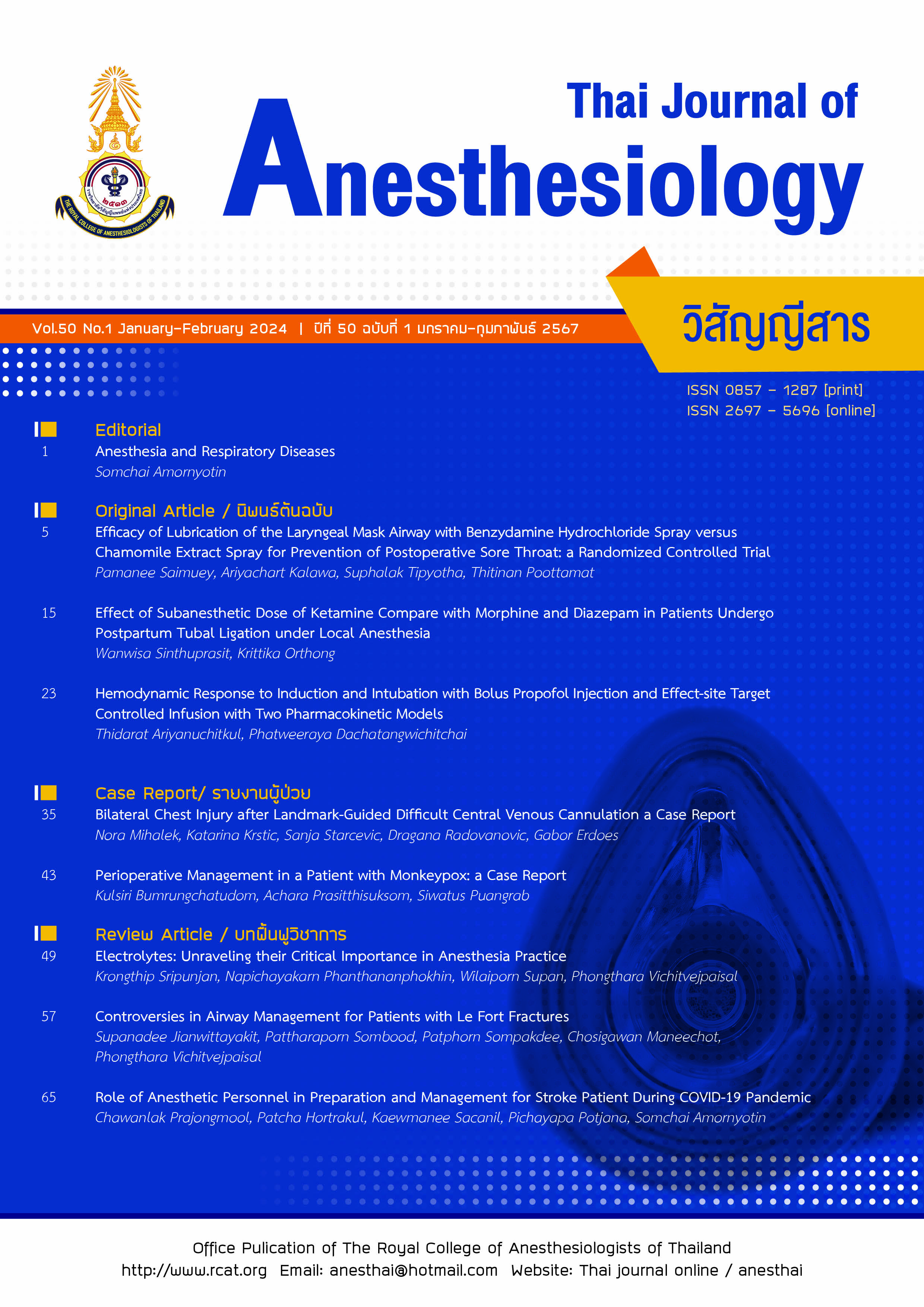Role of Anesthetic Personnel in Preparation and Management for Stroke Patient During COVID-19 Pandemic
Main Article Content
Abstract
The objective of this article is to represent the role of anesthetic personnel in anesthesia preparation and management of stroke patients during the COVID-19 pandemic in Siriraj Hospital. This article defines the characteristics and types of strokes and describes the management processes of anesthetic personnel, which start from admitting stroke patients to transferring them into wards during the COVID-19 pandemic. The management processes include preprocedural management, personnel, medication and pharmaceutical management. Dividing these processes results in anesthetic nurses working effectively as a team, minimizing management time, and maximizing the benefits for stroke patients.
Article Details

This work is licensed under a Creative Commons Attribution-NonCommercial-NoDerivatives 4.0 International License.
References
Amarenco P, Bogousslavsky J, Caplan LR, Donnan GA, Hennerici MG. Classification of stroke subtypes. Cerebrovasc Dis. 2009;27:493-501.
Donkor ES. Stroke in the 21st century: a snapshot of the burden, epidemiology, and quality of life. Stroke Res Treat. 2018;2018:3238165.
Suwanwela NC. Stroke epidemiology in Thailand. J Stroke. 2014;16:1-7.
Millán M, Dorado L, Dávalos A. Fibrinolytic therapy in acute stroke. Curr Cardiol Rev. 2010;6:218-26.
Powers WJ, Derdeyn CP, Biller J, et al. 2015 American Heart Association/ American Stroke Association focused update of the 2013 guidelines for the early management of patients with acute ischemic stroke regarding endovascular treatment. A guideline for healthcare professionals from the American Heart Association/ American Stroke Association. Stroke. 2015;46:3020-35.
Zhu H, Wei L, Niu P. The novel coronavirus outbreak in Wuhan, China. Glob Health Res Policy. 2020;5:6.
Amornyotin S, Parichatikanond P, Reunreung W. Anesthesia for embolization from 2003-2004 in Siriraj Hospital: a retrospective study. Siriraj Med J. 2007;59:161-3.
Amornyotin S, Promthong P, Reunreung W. Anesthesia for nuclear medicine procedures in children from 2002-2004 in Siriraj Hospital: a retrospective study. Thai J Anesthesiol. 2006;32:182-90.
Amornyotin S, Pranootnarabhal T, Chalayonnavin W, Kongphlay S. Anesthesia for gastrointestinal endoscopy from 2005-2006 in Siriraj Hospital: a prospective study. Thai J Anesthesiol. 2007;33:93-101.
Chalos V, van der Ende NAM, Lingsma HF, et al. National Institutes of Health Stroke Scale. An alternative primary outcome measure for trials of acute treatment for ischemic stroke. Stroke. 2020;51:282-90.
Hendén PL, Rentzos A, Karlsson JE, et al. General anesthesia versus conscious sedation for endovascular treatment of acute ischemic stroke: the AnStroke trial (Anesthesia During Stroke). Stroke. 2017;48:1601-7.
Gadek L, Szarpak L, Konge L, et al. Direct vs. video-laryngoscopy for intubation by paramedics of simulated COVID-19 patients under cardiopulmonary resuscitation: a randomized crossover trial. J Clin Med. 2021;10:5740.
Duan N, Gao W, Wang Q. Preparedness and disinfection of anesthetic equipment in COVID-19. J Clin Anesth. 2020;66:109924.
Abbas S, Rafique A, Abbas B, Iqbal R. Real-time polymerase chain reaction trends in COVID-19 patients. Pak J Med Sci. 2021;37:180-4.
Sureka B, Tiwari S, Garg PK, et al. COVID-19 pandemic: cleaning and disinfection-what should the radiologist know? Indian J Radiol Imaging. 2021;31(Suppl1):S207-11.


